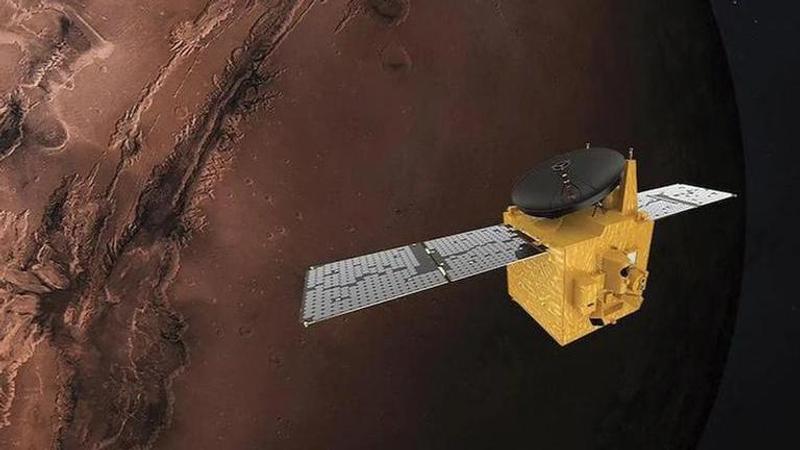Published 10:03 IST, February 10th 2021
Arab spacecraft enters orbit around Mars in historic flight
A spacecraft from the United Arab Emirates swung into orbit around Mars on Tuesday in a triumph for the Arab world's first interplanetary mission.

A spacecraft from the United Arab Emirates swung into orbit around Mars on Tuesday in a triumph for the Arab world's first interplanetary mission. Ground controllers at the UAE's space centre in Dubai rose to their feet and applauded when word came that the unmanned craft, called Amal, Arabic for Hope, had reached the end of its nearly seven-month, 300-million-mile journey and had begun circling the red planet, where it will gather detailed data on Mars' atmosphere.
The orbiter fired its main engines for 27 minutes in an intricate, high-stakes manoeuvre that slowed the craft enough for it to be captured by Mars' gravity. It then took a nail-biting 15 minutes or so for the signal confirming success to reach Earth. Tensions were high: Over the years, Mars has been the graveyard for a multitude of missions from various countries.
To a standing ovation, a visibly relieved Omran Sharaf, the mission's director, declared, "To the people of the UAE and Arab and Islamic nations, we announce the success of the UAE reaching Mars." Two more unmanned spacecraft from the US and China are following close behind, set to arrive at Mars over the next several days. All three missions were launched in July to take advantage of the close alignment of Earth and Mars.
Amal's arrival puts the UAE in a league of just five space agencies in history that have pulled off a functioning Mars mission. As the country's first venture beyond Earth's orbit, the flight is a point of intense pride for the oil-rich nation as it seeks a future in space. An ebullient Mohammed bin Zayed, the UAE's day-to-day ruler, was on hand at mission control and said: "Congratulations to the leadership and people of the UAE for the indescribable joy of the arrival at Mars."
About 60 per cent of all Mars missions have ended in failure, crashing, burning up or otherwise falling short in a testament to the complexity of interplanetary travel and the difficulty of making a descent through Mars' thin atmosphere. A combination of orbiter and lander from China is scheduled to reach the planet on Wednesday. It will circle Mars until the rover separates and attempts to land on the surface in May to look for signs of ancient life.
A rover from the US named Perseverance is set to join the crowd next week, aiming for a landing February 18. It will be the first leg in a decade-long US-European project to bring Mars rocks back to Earth to be examined for evidence the planet once harboured microscopic life. If it pulls this off, China will become only the second country to land successfully on Mars. The US has done it eight times, the first almost 45 years ago. A NASA rover and lander are still working on the surface.
For the UAE, it was the country's first venture beyond Earth's orbit. For months, the spacecraft's journey had been tracked by the state-run press with rapturous enthusiasm. Landmarks across the UAE, including Burj Khalifa, the tallest tower on Earth, have glowed red to mark Amal's anticipated arrival. Billboards depicting Amal tower over Dubai's highways. This year is the 50th anniversary of the country's founding, casting even more attention on Amal.
The celestial weather station settled into an exceptionally high Martian orbit of 22,000 kilometres by 44,000 kilometres. It joins six spacecraft already operating around Mars: three US, two European and one Indian. Amal had to perform a series of turns and engine firings to manoeuvre into orbit and achieve what has eluded so many before. "Anything that slightly goes wrong and you lose the spacecraft," said Sarah al-Amiri, minister of state for advanced technology and the chair of the UAE's space agency.
The success represents a tremendous boost to the UAE's space ambitions. The country's first astronaut rocketed into space in 2019, hitching a ride to the International Space Station with the Russians. That's 58 years after the Soviet Union and the U.S. launched astronauts. Thomas Zurbuchen, NASA's science mission chief, tweeted congratulations, saying: "Your bold endeavour to explore the Red Planet will inspire many others to reach for the stars. We hope to join you at Mars soon" with Persevere.
In developing Amal, the UAE chose to collaborate with more experienced partners instead of going it alone or buying the spacecraft elsewhere. Its engineers and scientists worked with researchers at the University of Colorado, the University of California at Berkeley and Arizona State University. The spacecraft was assembled at Boulder, Colorado, before being sent to Japan for launch last July.
The car-size Amal cost USD 200 million to build and launch; that excludes operating costs at Mars. The Chinese and US expeditions are considerably more complicated and expensive because of their rovers. NASA's Perseverance mission totals USD 3 billion. The UAE, a federation of seven sheikhdoms, is looking for Amal to ignite the imaginations of the country's scientists and its youth and help prepare for a future when the oil runs out. "This mission was never about just reaching Mars," said Omran Sharaf, Amal's project manager. "Mars is just a means for a much bigger objective."
(Image Credits: AP)
Updated 10:03 IST, February 10th 2021



